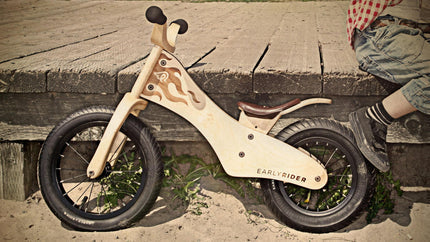
The great thing about starting your kid out on a quality balance bike is that the design allows your child’s natural curiosity and motor skills to lead the way. The geometries of Early Rider bikes have been honed over two decades to enhance this natural method of learning to ride and we’ve carefully optimized each balance bike in our range to provide your child with the perfect low center of gravity that’s essential for helping them discover, sustain and adjust their balance. You hardly need to step in, if at all, once they get the hang of it. Although initially it helps to give them a little bit of guidance, and bags of encouragement.
If you’re still at the stage of choosing the best balance bike for your kid, have a read of our complete guide to choosing a balance bike to help you make the right pick. Or if you’ve selected a ride and are raring to get them going here are a handful of hints to help get them rolling right.

Safety checks ahead of lift-off
Before any ride be sure to carry out the essential safety checks, both on them and the balance bike. Protecting their noggin is the number one thing, so start there. If you haven’t already got a great quality helmet, look for one with the necessary adjustment so you can tailor a snug fit. The Thousand Jr. Helmet with its simple dial-fit system is a great option if your kid is one or older. Once you’ve ensured their darling dome is well protected, turn your attention to the balance bike and get them to join in with you as you check the tire pressures and that everything is as it should be. Encouraging them to give the tires a quick squidge and to wiggle the handlebars is a great habit to build.
Saddling up like a little legend
At first it can help to lift your kid onto the saddle, particularly if they’re very young. That said, if they want to get on all by themselves, absolutely, applaud them for doing that. Just be there in case they do need a little help. They’ll likely want to hold the handlebars and then step over into the saddle, because it’s the most natural way to get on. Perhaps the most important thing at this stage is to encourage them to sit down properly on the seat, and not hover above it, because sitting and taking their full bodyweight off their legs is a key part of learning to stay steady and gain control on a balance bike.
From walking to gliding
Once they’re firmly sitting on their bike they may well start looking up at you for reassurance, or just to show you how happy they are with what they’re doing. As they should be, because now comes the really good bit… they’re going to start moving. Encourage them to look ahead, not at their feet or handlebars, and to start using their feet to propel themself forwards. It helps to give them a target to aim for and keep focused on - another parent or sibling placed 20 yards or so away.
Take things at their pace. If they lose interest after a few minutes, don’t worry. Keep the encouragement flowing. In their own time they’ll start scooting along naturally, and with enough momentum they’ll either start lifting their feet up on their own and start gliding, or they might need you to suggest they try. However they come to it, they’ll love it. Just be patient.
Speed control
It might initially seem a little odd that there are no brakes on their first balance bike, whether that’s the Classic, Lite, Bonsai, Charger or Big Foot, but that’s with good reason. As your child builds confidence, allowing them to instinctively develop speed control is every bit as important as them learning to stop. Of course, out the gate you want them starting on flat ground, and it’s here that they’ll gain a natural feel and understanding of how to speed up and slow down, and stop with their feet.
Once you’re happy with how they’re doing, introducing them to gentle slopes will give them a real thrill, and they’ll be able to adapt their new-found skills. Sure, they might go through their footwear a little faster than they would just walking around, but a well-scuffed pair of sneakers is a great sign that they’re thriving on their balance bike. If they’re starting to get more adventurous, and you’d like them to try some more rugged trails, that’s when it’d be an idea to move them onto a Bigfoot.
Give them their 10-a-day
It’ll come as little surprise that the key to seeing your child develop their confidence and skill is to have them practice every day. We advocate 10 minutes a day. The ol’ little and often approach is best, and keeping it light and fun. It should never be a chore, so be sure to let them improve at their pace and don’t try to overextend or overwhelm them with long or challenging sessions. If you can build playtime on their balance bike into their daily routine you’ll see them develop in leaps and bounds.
And don’t forget to share their progress with us @earlyriderbikes



Share:
Sizing 101: Balance bikes for toddlers